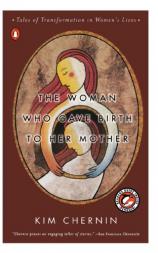The Woman Who Gave Birth To Her Mother
About the Book
The Woman Who Gave Birth To Her Mother
Whether we are aware of it or not, we are all storytellers. Our stories can be as simple as "the time I locked my keys in the car," or "the fish that got away." Or they can be complex and difficult to relate—stories less for relating an experience than for preserving that experience in a manageable form. The storytellers in Kim Chernin's The Woman Who Gave Birth to Her Mother are preserving the experiences of growing up with their mothers. Some tell their stories reluctantly; some in what seems like a single breath. One woman's story changes each time she tells it; another's offers a startling, hidden revelation. For each of these women, the process of telling a story is an opportunity to work through paralyzing pain, fear, loss or anger so that she can move on with her life. It is this transformation, and the ability to achieve it, that Chernin brings to light in this moving book.
Chernin's book offers two primary messages. One is the idea that through telling stories or by objectifying certain events in our lives, we can create an emotional distance between ourselves and those events. This distance allows us the freedom to explore those events less painfully—and even to be healed through the telling of them. As a writer, Chernin reaches for the same technique she employs in her clinical practice, in which she is ethically (and legally) required to maintain confidentiality between herself and her client. By disguising the women in her stories Chernin is able not only to protect their identities, but also, perhaps, to more effectively explore the importance of the stories themselves.
The other message is illustrated by a metaphor—the act of giving birth—that offers images of renewal and possibility, of creation and survival. By giving birth to her mother, a woman can re-create her own experience of childhood and provide herself with the kind of mothering she needs but perhaps never had. In this book, Chernin identifies a series of stages women go through in telling their "mother stories." Like most natural things, these stages do not occur linearly but cyclically. They are part of a transformative process that may take months or years to complete—or it may never be completed. What Chernin shows us is that learning to identify any given stage is more important than getting through it as it is through self-awareness that we grow. As a psychoanalyst, Chernin understands that progress is more often than not the result of breaking down an idea to examine its parts, of slowing down a process to fully experience it. This takes time, patience and courage. The mother-daughter relationship is both complicated and fragile. It is also strong, and not easily changed. For women who want to start the process of that change, The Woman Who Gave Birth to Her Mother offers understanding and guidance as well as women with compelling stories of their own.
The Woman Who Gave Birth To Her Mother
- Publication Date: August 1, 1999
- Paperback: 256 pages
- Publisher: Penguin (Non-Classics)
- ISBN-10: 0140284664
- ISBN-13: 9780140284669








